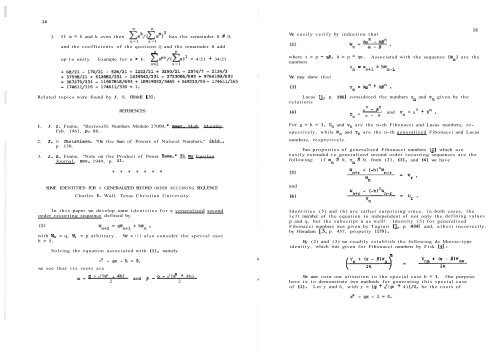Vol. 4 No 1 - Pi Mu Epsilon
Vol. 4 No 1 - Pi Mu Epsilon
Vol. 4 No 1 - Pi Mu Epsilon
Create successful ePaper yourself
Turn your PDF publications into a flip-book with our unique Google optimized e-Paper software.
hwn-ln3. If m = 1 and k even then Z X ~ / ( ~ has X the ~ ) remainder ~ R # 0,x=l x=land the coefficients of the quotient Q and the remainder R addn nup to unity. Example for n = 1: x 2 Â ° / ( s ) = 4/21 + 34/21x=l x=lRelated topics were found by J. S. FRAME [3].REFERENCES1. J. S. Frame, "Bernoulli Numbers Modulo 27000, " Amere Math. Monthly,Feb. 1961, p. 88.2. J. G. Christiano, "On the Sum of Powers of Natural Numbers," ibid.,p 150.3. J. S. Frame, "<strong>No</strong>te on the Product of Power Sums, " & <strong>Epsilon</strong>Journal, <strong>No</strong>v- 1949, p. 21.nWe easily verify by induction thatwhere A = p - 4, B = p - qa. Associated with the sequence [w] are thenumbersWe may show thatyn = wn+l +(3) Yn = ?LYn + ~ , 9 ~Lucas [A, p. 3961 considered the numbers U and V given by therelations(4)For g = h = 1, Uspectively, while Wnumbers, respectively.a n - llnUn = a- 8.and V = a n + 8" .and Vn are the n-th Fibonacci and Lucas numbers, re-and Yn are the n-th generalized Fibonacci and LucasTwo properties of generalized Fibonacci numbers [21 which areeasily extended to generalized second order recurring sequences are thefollowing: if wn # 0, Yn # 0, from (21, (3), and (4) we haveSOME IDENTITIES FOR A GENERALIZED SECOND ORDER RECURRING SEQUENCECharles R.Wall, Texas Christian Universityand(6In this paper we develop some identities for a yeneralized secondorder recurring sequence defined bywith Wo = q, W, = p arbitrary. We will also consider the special caseh = 1.Solving the equation associated with (11, namelywe see that its roots area=Y2 - gx-h=O," + 4h)2 2+ J(@ + 4h) and 8 = 9 - -/^Identities (5) and (6) are rather surprising since, in both cases, theleft member of the equation is independent of not only the defining valuesp and q, but the subscript n as well! Identity (5) for generalizedFibonacci numbers was given by Tagiuri [A, p. 4041 and, albeit incorrectly,by Horadam [3, p. 457, property (17) 1.By (2) and (3) we readily establish the following de Moivre-typeidentity, which was given for Fibonacci numbers by Fisk [$I :We now turn our attention to the special case h = 1. Our purposehere is to demonstrate two methods for generating this special caseof (1). Let y and 6, with y = [g + J (ga + 4) ]/2, be the roots of
















